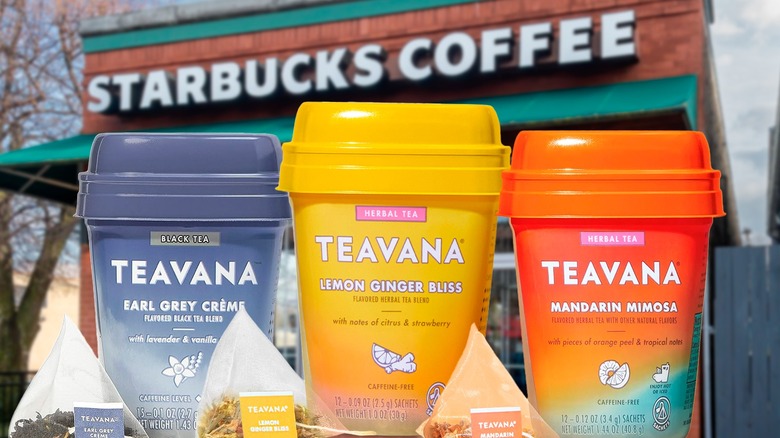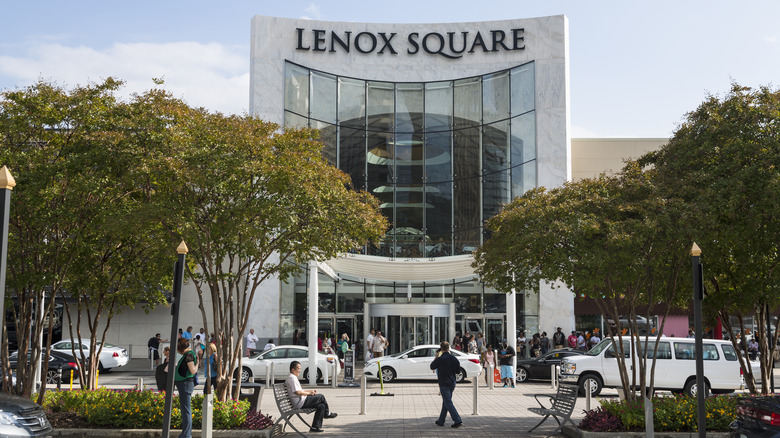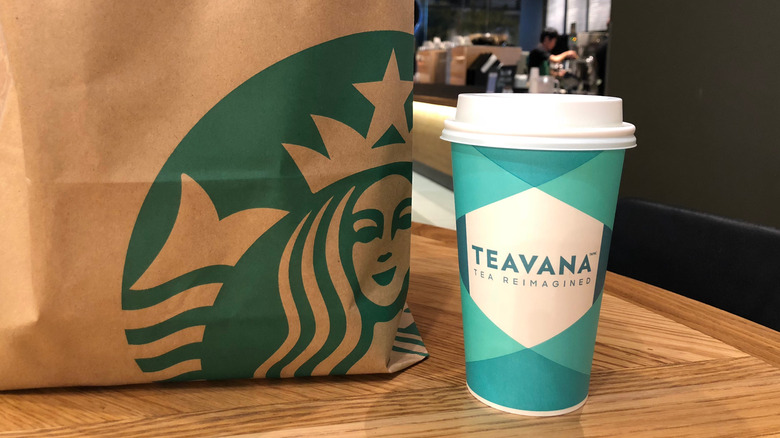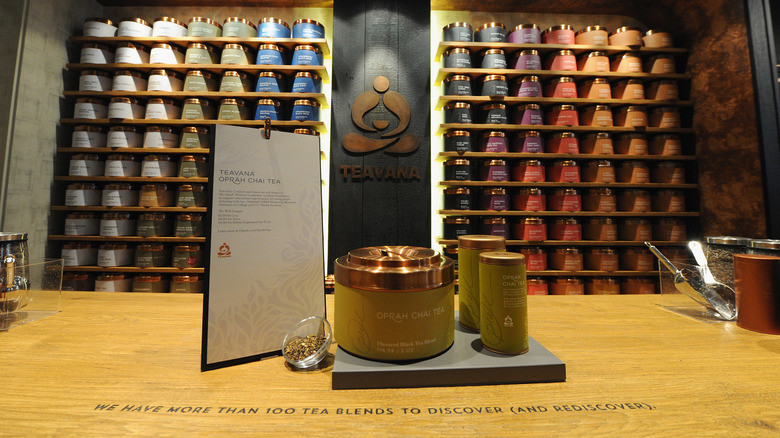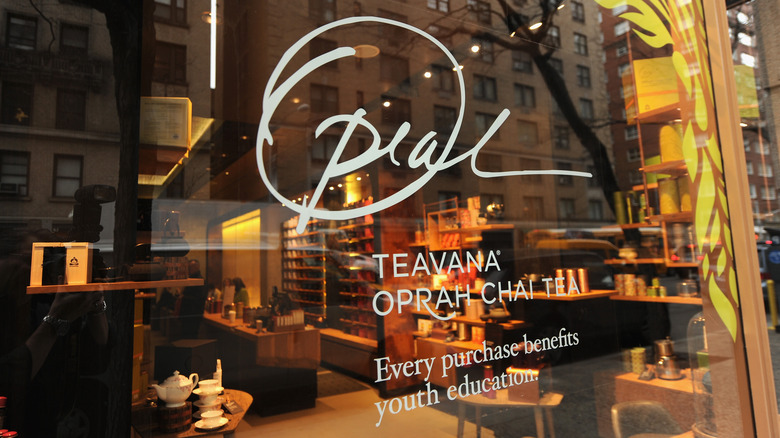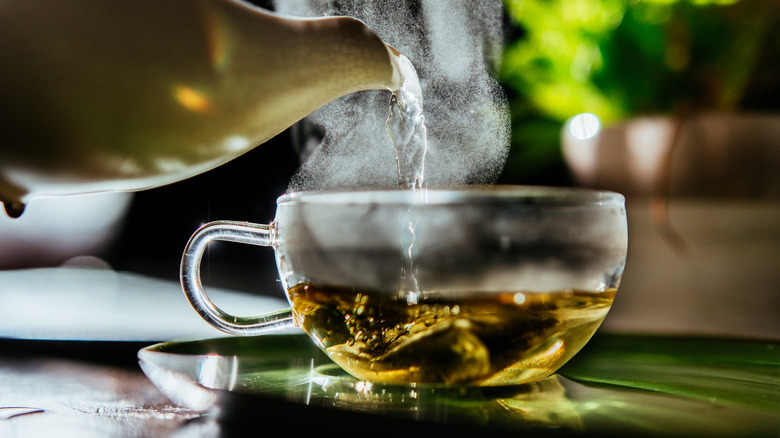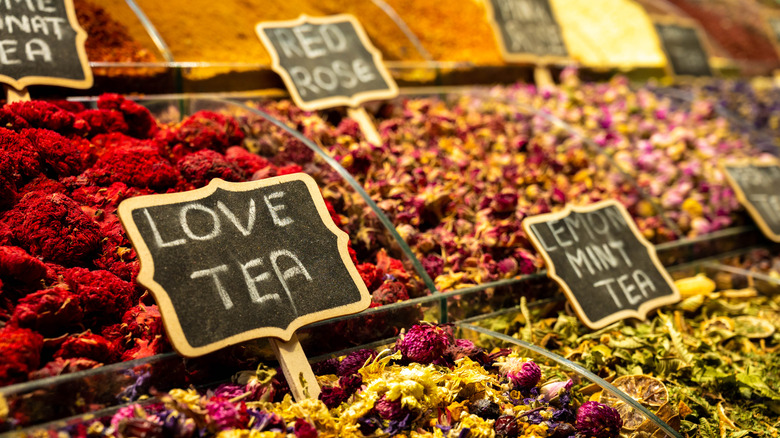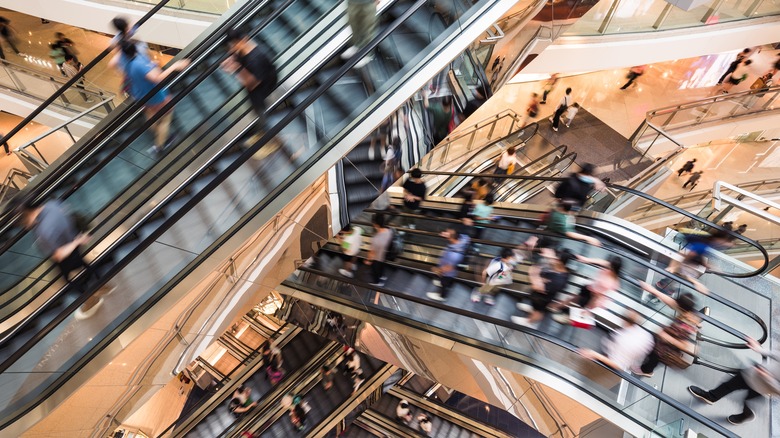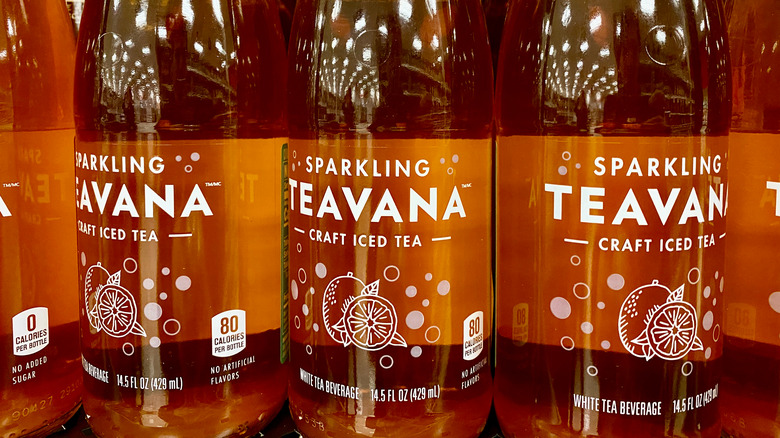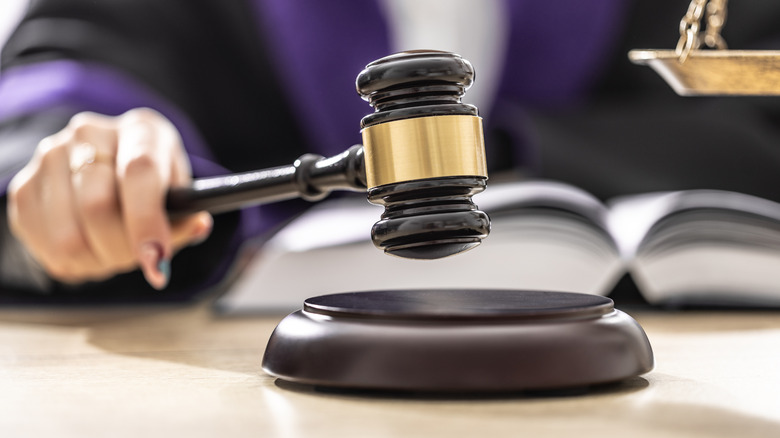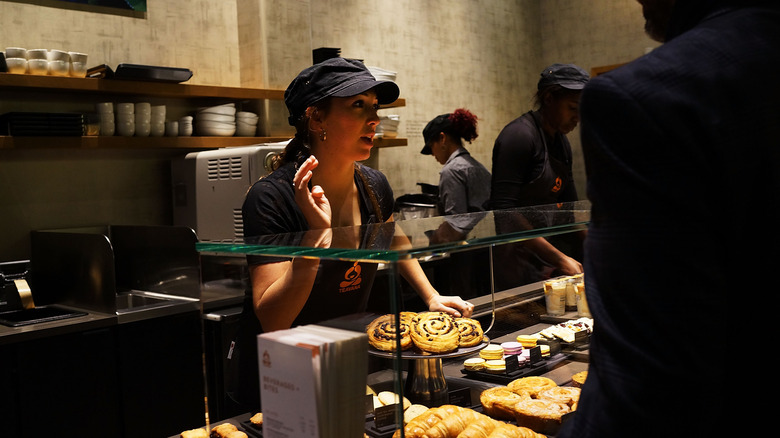The Rise And Fall Of Teavana
In November of 2012, Starbucks announced it would buy Teavana, the Nirvana of specialty tea chains. In much the same way that travel to the Americas was intended to open up the riches of the Indian spice trade, the Teavana purchase promised to put Starbucks front and center of what it estimated to be a $90 billion dollar tea industry. And all of this would happen without Starbucks being required to start a tea brand of its own. Starbucks had already purchased Tazo Tea in 1999. The Teavana deal would allow the coffee giant to make even more inroads into the tea world.
The plan was simple. The coffee retailer would take over specialty Teavana shops that existed in American shopping malls. Wedged between Peanuts holiday displays and blue-hued aquariums filled with sharks, Teavana tea stores' assortment of hundreds of teas and counter reps called "teaologists" stood in stark contrast to the opulent vibe of 1990s mall life.
These "shrines to tea," as Starbucks CEO Howard Schultz referred to them in the Huffington Post, offered a mindful moment to shoppers before they continued on to Macy's, the Mac counter, or the mall pet store. The coffee-tea business deal, which included brand pairings with luminaries like Oprah Winfrey, seemed to be a match made in hot beverage heaven. But for all its promise, the purchase of the so-called "Heaven of Tea," turned out to be anything but.
Teavana began in the late '90s
For a company that would eventually be bought out by Starbucks, Teavana's beginnings were about as start-up as they come. Founded in Atlanta in the late 1990s with the life savings of Andrew and Nancy Mack, the tea company reflected the Macks' love of tea culture and a dream of sharing that with others.
The pair had reason to be hopeful. According to Atlanta Magazine, with 360 people moving to the city a day, Atlanta's population grew by 43% during the '90s. Of equal importance was the abundant mall space (and mall culture) in Atlanta, which included destinations like Lenox Square, Mall of Georgia, and Town Center at Cobb. In fact, it was in Phipps Plaza in Lenox Square where Teavana had its first store.
Given how popular malls were in the 1990s, the Macks had good reason to believe that if they built it, people would come. For a time, mall-goers did visit the place that was meant to be "part tea bar, part tea emporium." By the mid-2000s, there were 50 tea shops under the Macks' care, and in 2011, Teavana, which was originally called "Elephant Tea Co.," went public, raking in $121 million on its IPO, per Tea Biz. When the Macks finally sold the company to Starbucks, the tea chain boasted more than 300 stores. The sale netted the Macks $335 million dollars, and Andrew Mack retained a position with Starbucks, which he held until he retired in 2014.
Buying the tea chain cost Starbucks over $600 million dollars
Starbucks had a grand vision for the world of tea, and Teavana was supposed to the doorway. As reported by Reuters, the goal was supposed to be bolstered by the $620 millon purchase of the specialty tea chain in 2012. Given that the coffee giant also acquired Evolution Fresh and La Boulange Bakery that same year, calling the Teavana purchase one of the "smartest acquisitions" the coffee company had made spoke to the optimism that Starbucks' leadership had about the purchase. It's a deal that cost Starbucks $15.50 per Teavana share, according to Financier Worldwide, which was a 50% increase per Hartford Business Journal.
Starbucks intended to use the rollout of a stand-alone Tazo store in Seattle as a possible business model for the Teavana brand. The coffee retailer had reason to believe that the tea portion of its business would break new ground. Starbucks enjoyed $1.4 billion in sales from the Tazo brand at the time of the Teavana purchase. It had also turned its 11 original stores into thousands of retail outlets, so its plans to take Teavana from 300-plus stores to 500 stores within three years of the deal seemed doable. But the coffee giant's plans didn't end there. According to Financier Worldwide, Starbucks also intended to introduce packaged versions of Teavana products to supermarkets and grocery stores, too.
Starbucks overestimated the size and scope of the tea market
When Starbucks bought Teavana, the company projected that the worldwide tea market to hold about $90 billion in sales, and the coffee giant wanted a piece of it, according to a 2014 CNBC report. By the time that the CNBC story aired, Starbucks was nearly two years into its Teavana deal. Initially, things looked good for the Starbucks-Teavana merger.
The problem was there was a big difference in the projected numbers for the global tea market — a $50 billion difference. Statistica reports that in 2012, the herbal tea market only accounted for around $40 billion of the tea market. Additionally, Americans were also having a love affair with ready-to-drink and canned teas in 2012, leading to those bevvies having a market share of over 19%, according to BevIndustry.com.
Most of those drinks were sold in convenience and grocery stores and other similar retailers. Those establishments weren't exactly the tea bar locations that Starbucks had in mind when it purchased the mall-based chain. Demand for loose teas during the same time period was tiny by comparison, not such good news for Teavana, a company that was founded on selling loose teas to mall customers. And because Starbucks was always considered a destination business, getting people into buy-and-leave stores, like Teavana, was challenging.
The coffee giant intended to create tea bars
In the 1980s, Starbucks had only 11 stores to its name, and as for its sales? Back then, it was whole beans or nothing at the 'Bucks. Things changed for Starbucks brewed coffee in 1987, when the company opened its first espresso bar. Fast forward to 2012 when the mermaid-forward brand bought Teavana with full intentions of following the same business model that turned plain coffee beans into full-fledged coffee shops.
Prior to the Starbucks acquisition, Teavana had a famous wall of tea but little else to encourage visitors to sit down and stay awhile. Starbucks, which began as Starbucks Coffee Tea & Spices, hoped it could correct the dearth of tea bars in the world by opening its own line of establishments that featured specialty tea drinks for the masses.
In October of 2013, Starbucks realized that goal by opening Teavana Fine Teas + Tea Bar on the Upper East Side of Manhattan — the first of its kind. In many ways, the concept really was the Starbucks of tea, right down to its Teavana-themed merchandise, tea-inspired snacks, and tea lattes. For tea lovers, the atmosphere of the tea bar spawned a love of ritualistic tea drinking, and according to reviews on Yelp, many a tea drinker loved the experience and the bar while it lasted.
Teaologists introduced customers to the 'Heaven of Teas'
Starbucks has baristas. Teavana had teaologists, and hopes were high that the twain would intersect in harmony. As for the teaologists, they would be on-site educators and tea drinkers extraordinaire, who passed on their love of high-end tea and all the rituals that go with it, to the customers who came into Teavana stores around the world.
Ideally, customers would learn about the beverage's history and through the process of education become inspired to buy one of the loose leaf teas that the company sold. The teaologist was such an important role in the company that when the company worked with Oprah Winfrey to develop a signature Teavana Oprah Chai for the Oprah Winfrey Leadership Academy Foundation, the OWN mogul worked directly with the lead teaologist to create the creamy cinnamon- and ginger-flavored drink.
It was also a teaologist, Naoko Tsunoda, who oversaw tea development at the tea company — not an easy task. More than 40 countries grow tea around the world, and conditions like climate, soil conditions, grower knowledge, and even the weather all play a role in tea development. And given that the history of tea, going all the way back to ancient China and Japan, is about 4,000 years old, Tsunoda (and the company's other teaologists) had their work cut out for them.
The coffee company intended to tap into the wellness market
Wellness trends in 2012, the same year that Starbucks purchased Teavana, indicated that health access would move into the retail space. While much of this might have centered around places like Walgreens and Safeway, wellness trends also showed up in other retail spaces; Starbucks was a part of that.
The Seattle-based coffee brand had already introduced smoothies, green coffee refreshers, and cold-pressed juices to its line-up in 2009, 2012, and 2014, respectively. The purchase of Evolution Fresh, a wellness juice brand, additionally bolstered Starbucks' standing in the wellness market. And of course, Teavana teas also had a role to play, with healthy tea offerings that sported names like "Defense," "Rejuvenate," "Rev Up," and "Purity." These drinks would have undoubtedly contributed to the zen vibes and serene quotes that were found in Teavana stores. They would have also supported Starbucks' claim that each of its drink options would "allow customers to customize beverages to meet their wellness goals."
But eventually, Starbucks sold Evolution Fresh to Bolthouse Farms, and changed the direction of Teavana's business model. It had to, in order to keep up with a restaurant and beverage market that was more trending towards interesting food choices for lunch rather than sit-down tea bars — even ones that aligned with wellness.
Teavana faced some stiff competition in the tea market
Ironically, when Starbucks purchased Teavana in 2012, it became its own rival in the tea market. It had already purchased Tazo Tea in 1999, effectively making the coffee retailer the owner of two competing tea brands. However, it wasn't only Tazo that the Starbucks/Teavana brand had to contend with. Stash Tea, Argo Tea, DavidsTea, Talbott's Tea, and Mahalo Tea all had operations between the years 2012 and 2018. Those were the primary years in which Starbucks took acquisition of Teavana and then subsequently closed all of the tea company's brick-and-mortar stores down.
Additionally, many of them — Mahalo, DavidsTea, Argo, and to a lesser degree, Stash — featured one or more business elements that were similar to Teavana's. Similarities among the brands included the sale of loose leaf teas out of specialty tea shops, or deals to market packaged wares within grocery stores and other distribution outlets, like Amazon and QVC.
It's also worth pointing out that both coffee and iced tea count among the top five drinks sold in any restaurant, (per Nation's Restaurant News). In other words, the Starbucks/Teavana brand emerged into a market already chock full of competitors using a similar business model. Although Starbucks eventually sold Tazo Tea to Unilever in 2017, with few elements to distinguish Teavana from its competition, Starbucks' new tea brand had difficulty standing out in the crowd.
Being sold in shopping malls didn't help the tea company's prospects
Once considered a thing of genius, the Teavana business model faced an issue that plenty of retailers began to grapple with in the late-1990s and early 2000s: competition from online retailers and even blowback from store-closing hurricanes. Once a beacon for morning power walkers and teens shopping for clothes in their off hours, by the time 2017 rolled around, mall-based retail bankruptcies were commonplace.
The people who once went to the mall when they were bored started shopping at home on sites like Amazon and Etsy. Or they gravitated toward the kind of specialty retail outlets that sold one-of-a-kind pieces, items which they discovered thanks to the online influencers proclaiming the individuality of those wares. It was also the case that people who once ate dinner in mall-based restaurants multiple times a week started spending more time home cooking. Teavana, with some 350-plus mall-based stores and a business set-up that didn't always encourage people to sit down and sip with friends, was in the wrong place at the wrong time.
It's also worth remembering that Starbucks' other tea acquisition, Tazo Tea, went on the chopping block in 2017, too. The Seattle-based java company intended to refocus its efforts on coffee sales once again. Tazo Tea became the proverbial canary in the tea-sales coal mine. The announcement of Teavana closing all its locations came around that time, too.
More than 300 stores closed in the end
The 500 Teavana stores that Starbucks bosses had hoped to open never materialized. It only took about five years for the brand to go from mall-based stores with loose leaf specialty tea (and a handful of sit-down tea bars) to packaged items sold at online outlets. It also developed a bottled beverage agreement with Anheuser Busch. The latter deal helped the tea company move into the ready-to-drink beverage market by the beginning of 2017. Customers who wanted more traditional tea offerings were forced to look for boxed Teavana teas on online outlets like Amazon and Walmart.
Those new incarnations of Teavana teas came at the expense of more than 300 stores that Starbucks purchased in the original 2012 agreement. Eventually, all of the 300-plus brick-and-mortar stores closed down. Most, but not all, of them were located in shopping malls in the U.S., Canada, Mexico, and the Middle East. At least some of the 3,000 employees who worked at Teavana stores found employment at another local Starbucks coffee shop. It was a somewhat lackluster end to a company concept that was supposed to provide the perfect cup of tea for loose leaf connoisseurs. Instead, Teavana specialty teas joined the ranks of beverages that aren't quite wine coolers and sodas but not exactly exotic brews of Earl Grey, either.
There were numerous legal battles that dragged things down
When you're trying to close down an unprofitable portion of a business, there are many issues than can crop up, like being stuck in a lease agreements, for example. This was something that hit Starbucks right straight in the face when the company announced that it would close 379 Teavana locations in the late part of 2017. As it turns out, more than 70 mall locations that housed Teavana stores were managed by Simon Property Group (SPG), which obviously wanted all the money owed as guaranteed by the lease agreements.
To bypass Starbucks' intention to close the Teavana stores in its locations, SPG filed a lawsuit against the coffee retailer. A judge in Indiana agreed with the property management company — the number one commercial property outfit in the country — forcing Starbucks to keep 70-plus locations open. The injunction meant that Starbucks had to honor the SPG leases, which was no small thing, given that some of the coffee company's leases with the group didn't run out until 2027.
However in 2018, news broke that the two companies had settled their disagreement over the leases. Few details of the agreement emerged, though after the two companies settled, Teavana stores formerly affected by the lease agreements began to close within days. The issue highlighted how precarious brick-and-mortar-based businesses are in the Age of the Internet.
Stand-alone Teavana tea bars morphed into Starbucks locations
In what might be the ultimate display of alchemy, Starbucks turned tea into coffee, and it only took a couple of years to do it. In January 2016, Starbucks announced that its concept tea bars in New York and Beverly Hills would cease being Teavana tea bars and become Starbucks coffee shops in their stead. Only the Teavana store in University Village near the University of Washington would remain open for business. The rationale behind the morph was chalked up to an evolving business model which would see the Teavana wares move away from tea-branded stores and into already-established Starbucks coffee shops.
Teavana tea sales in Starbucks branded stores accounted for a billion dollars in sales that year. It seems that keeping the Teavana brand without the Teavana tea bars was a logical and profitable compromise in the evolving business model. The tea bars weren't the only casualty of the coffee chain's woes during that time. The bakery chain, La Boulange, also owned by Starbucks would be shuttered as well, despite the coffee giant's original plans to stock its coffee shops with wares from the bakery chain. As for Teavana, Starbucks still sells limited pre-packaged products in-store purchase and at-home consumption. With that said, market rumors suggest that even these may be heading for discontinuation.
